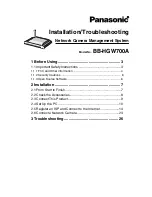
The third type of measurement command includes a cyclic redundancy check or checksum at the
end of the returned data and works with both the M and C type commands. The checksum
generated by the sensor will be evaluated by the data logger to determine if data was lost during
transmission. This is a valuable measurement tool when using long cable lengths or trying to
diagnose a problem.
(p. 38) provides examples of using the SDI-12 commands. In these
examples, a is the SDI-12 sensor address (default of 0). See
(p. 39) for the measurement
commands recognized by the CS475A, the values returned with each command, and the
response time of the sensor to each command.
Table 8-3: Measurement examples
Command
Description
aMb!
Start measurement
data logger transmits: 0M!
Sensor returns: 00014 (returns four values in 1 s)
1
Sensor returns service request if it is done measuring early: 0
data logger transmits get data command: 0D0!
2
Sensor transmits: 0+sss.ss+ddd.dd+vv.vvv+ee
3
aCb!
data logger transmits: 0C!
Sensor returns: 00014 (returns four values in 1 s)
4
data logger transmits get data command after 1 s has passed or on the next
scan through the program: 0D0!
2
Sensor transmits: 0+sss.ss+ddd.dd+vv.vvv+ee
5
1
Regardless of the time to respond, the data logger will wait for the data to be returned before moving on in the
data logger program.
2
Depending on the number of characters that needs to be returned, the data logger will increment from
0D0!
to
0D1!
up to
0D9!
.
3
aMCb!
– Start measurement with checksum will follow the same pattern as the
aMb!
command however it will
add a checksum to the end of the returned data. Sensor returns: 0+sss.ss+ddd.dd+vv.vvv+ee.ee<CRC>
4
When using the concurrent command, the data loggerwill continue doing other measurements and then return
to collect the data once the measurement time has lapsed.
5
aCC!
– Start measurement with checksum will follow the same pattern as the
aC!
command. Sensor returns:
0+sss.ss+ddd.dd+vv.vvv+ee.ee
CS475A Radar Water Level Sensor
38
















































